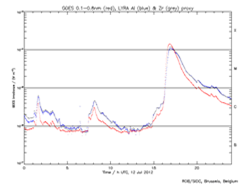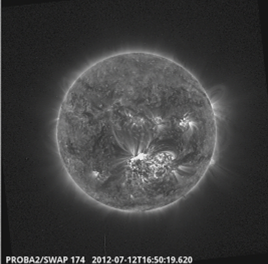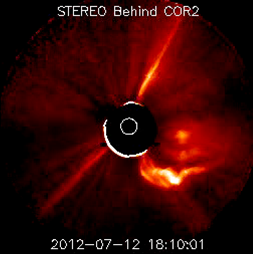Zonnevlekkengroep NOAA 1520 produceert een sterke zonnevlam op 12 juli. De gevolgen voor België blijven voorlopig beperkt.
Le groupe de taches NOAA 1520 a produit une forte éruption solaire le 12 juillet. Les conséquences pour la Belgique sont pour le moment limitées.
Active sunspot group NOAA 1520 produced a strong solar flare on July 12. The consequences for Belgium are limited for the moment.
 |
 |
 |
| The X1.4 flare measured by the LYRA instrument onboard Proba-2. | The solar flare seen by the SWAP telescope on board Proba-2. | The ejected particle cloud seen by the STEREO-spacecraft (Earth is at the right). |
A movie made by the SWAP telescope onboard the PROBA2 satellite can be found here.
Movies from the SDO satellite are here.
Movies of the ejection of the particle cloud seen by the STEREO coronagraphs are here.
Ruimteweer-rapport: 12 juli 2012
Een sterke uitbarsting (zonnevlam) vond plaats op de Zon op 12 juli 2012 omstreeks 18u50 Belgische tijd. Een plasmawolk werd de ruimte ingeslingerd en een protonenstorm is aan de gang. De gevolgen voor België zijn op dit moment beperkt. Updates zijn beschikbaar (in het Engels) op onze website. De stijgende activiteit is normaal in deze fase van de zonnecyclus: Meer en sterkere uitbarstingen worden verwacht tijdens de komende jaren.
EVENT:
Op 12 juli 2012 omstreeks 18u50 Belgische tijd werd een krachtige X1.4 zonnevlam waargenomen in de grote en complexe zonnevlekkengroep NOAA 1520.
Aangezien het in België reeds avond was, waren de verstoringen van de HF radiocommunicatie ten gevolge van de zonnevlam hier eerder beperkt.
De uitbarsting ging eveneens gepaard met een kleine protonenstorm, zonder evenwel ernstige gevolgen voor satellieten.
De X1-flare stootte ook een plasmawolk uit die recht op ons afkomt. De vermoedelijke aankomst op Aarde wordt verwacht in de loop van 14 juli 2012.
VERWACHTINGEN:
Een gelijkaardige krachtige zonne-uitbarsting kan zich voordoen tijdens de komende dagen, met de mogelijkheid tot sterke degradatie van HF communicatie boven België.
De protonen flux daalt vermoedelijk in de loop van deze dag onder het storm-niveau, zonder verdere effecten voor de Aarde.
De aankomst van de plasmawolk wordt verwacht rond de middag van 14 juli, evenwel met een grote onzekerheid (meerdere uren). Een sterke geomagnetische storm wordt verwacht, met voelbare gevolgen voor navigatie (GPS) en satellieten (sleepkracht). De impact van de storm is afhankelijk van de richting van magnetisch veld van de plasmawolk: Een zuidwaartse richting zal de storm versterken. Indien de plasmawolk 's avonds of 's nachts aankomt, bestaat er voor België ook een matige kans op poollicht (bij helder weer).
Bulletin météo spatiale: 12 juillet 2012
Une forte éruption solaire a été observée le 12 juillet 2012 vers 18h50 (heure belge). Consécutivement, un nuage de plasma a été éjecté dans l'espace. Les conséquences pour la Belgique sont limitées pour le moment. Les mises-à-jour seront disponibles (en Anglais) sur notre site web. L'augmentation de l'activité est normale dans cette phase du cycle solaire. Dans les prochaines années, des éruptions plus fréquentes et de plus forte intensité sont attendues.
EVENEMENT:
Le 12 juillet 2012 vers 18h50 (heure belge), une forte éruption solaire de magnitude X1.4 a été observée dans le grand et complexe groupe de taches NOAA 1520.
Comme l'éruption solaire a eu lieu en fin de journée en Belgique, peu de perturbations ont été signalées pour les communications HF.
L'éruption a légèrement augmenté le flux de protons, sans conséquences graves pour les satellites.
L'éruption a aussi éjecté un nuage de plasma. Ce nuage se dirige directement vers la Terre. Son arrivée est prévue dans le courant du 14 juillet.
PREVISIONS:
Dans les prochains jours, d'autres fortes éruptions peuvent survenir, avec une dégradation possible de la communication HF au-dessus de la Belgique.
Le flux de protons descendra en-dessous du niveau d'alerte, probablement dans le courant de la journée et sans effet sur la Terre.
L'arrivée du nuage de plasma est prévue pour le 14 juillet vers midi, néanmoins avec une grande incertitude (plusieurs heures). Un fort orage géomagnétique est attendu, avec des conséquences pour les systèmes de navigation (GPS) et les satellites (orbitographie). L'impact de l'orage dépend fortement de l'orientation du champ magnétique du nuage de plasma. Une direction vers le Sud renforcera l'orage. Si le nuage arrive à la fin de la journée ou pendant la nuit, il existe une chance de voir des aurores en Belgique (par temps clair).
Space Weather report: July 12, 2012
A strong flare occurred on the Sun on July 12, 2012 around 18h50 Belgian time. A magnetized plasma cloud was ejected into space and a proton storm is ongoing. For Belgium, the consequences have been limited so far. Updates are available on our website. The rise of activity is normal in this phase of the solar cycle: More and even stronger eruptions are expected in the next years.
EVENT:
On July 12, 2012, around 18h50 Belgian time, a strong X1.4 solar flare was observed in the big and complex sunspot group NOAA 1520.
As the eruption occurred during the evening hours (in Belgium), the perturbation of the HF radio-communication due to this flare here was fairly limited.
The eruption was also accompanied by a small proton storm, without important consequences for satellites.
The X1-flare also ejected a plasma cloud which is heading directly towards Earth. The arrival of the cloud at the Earth is expected for July 14, 2012.
FORECAST:
A similar strong solar flare can be produced in the next few days, with a possibility on strong degradation of the HF radio communication above Belgium.
The proton flux will descend under the storm treshold, presumably during this day and without further consequences for Earth.
The arrival of the plasma cloud is expected for July 14, around noon. However, there is a rather large uncertainty in this prediction (several hours). A strong geomagnetic disturbance is expected, with noticeable effects for navigation (GPS) and satellies (drag force). The impact of the storm depends strongly on the direction of the cloud's magnetic field: A southward directed field will strengthen the geomagnetic storm. If the plasma cloud arrives during the evening or night hours, a moderate chance exists for aurorae visible from Belgium (weather permitting).
 |
 |
 |





